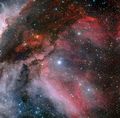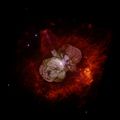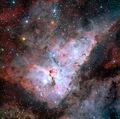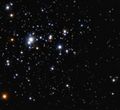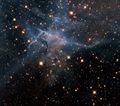القاعدة (سديم)
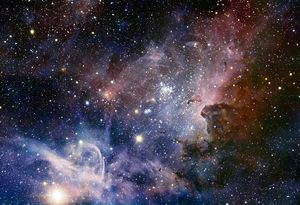
| |
| بيانات المراقبة: حقبة J2000.0 | |
|---|---|
| النوع: | Emission |
| المطلع المستقيم: | 10h 45m 08.5s[1] |
| الميل الزاوي: | -59° 52′ 04″[1] |
| المسافة: | ~6500-10000 س.ض [1] |
| السطوع الظاهري (V): | +1.0 |
| أبعاد ظاهرية (V): | |
| برج: | القاعدة |
| الخصائص الطبيعية | |
| القطر: | ~10 pc |
| النصوع المطلق (V): | ~10.8 |
| خصائص هامة: | Includes dark nebula Keyhole Nebula |
| أسماء أخرى: | الفهرس العام الجديد 3372،[2] ESO 128-EN013,[1] GC 2197[1] |
| انظر أيضاً: سديم انتشاري, قائمة السدائم | |
القاعدة Carina Nebula، هي سحابة كونية عظيمة الاتساع تحوط عدة تجمعات نجمية مفتوحة ويرمز لها طبقاً للفهرس العام الجديد بالرمز NGC 3372. وتعتبر سحابة كوكبة القاعدة إلى جانب إتش دي 93129إيه، من أكثر السحب الكونية التي تحتوي على أكبر النجوم وأشدها لمعانا في مجرتنا، مجرة درب التبانة . وتقع سحابة القاعدة على بعد بين 7.000 إلى 10.000 سنة ضوئية من الأرض. وهي تقع في كوكبة القاعدة ، وتحوي عددا كبيرا من النجوم من التصنيف O-type.
انفصلت تلك السحابة الجزيئية عن سحابة القاعدة، وترى النجوم حديثة النشاة بالقرب منها وقد ظهر لونها يميل إلى اللون الأحمر بسبب قدرة الضوء الأحمر على النفوذ من خلال الغبار الكوني المحيط بهم . يبلغ اتساع تلك السحابة الجزيئية نحو 2 سنة ضوئية وقام تلسكوب هابل الفضائي بالتقاطها. خلال عدة ملايين من السنين سوف تتشتت تلك السحابة تحت تأثير الحرارة والضوء الصادرة من النجوم القريبة.
. . . . . . . . . . . . . . . . . . . . . . . . . . . . . . . . . . . . . . . . . . . . . . . . . . . . . . . . . . . . . . . . . . . . . . . . . . . . . . . . . . . . . . . . . . . . . . . . . . . . . . . . . . . . . . . . . . . . . . . . . . . . . . . . . . . . . . . . . . . . . . . . . . . . . . . . . . . . . . . . . . . . . . . .
أجرام في سديم القاعدة
إيتا

معرض الصور
The Carina Nebula. Credit ESO.
The Carina Nebula around the Wolf–Rayet star WR 22. Credit ESO.
A Hubble Space Telescope (HST) false-color image/diagram of the Carina Nebula (Zoomable version); Credit: HST/NASA/ESA.
Super massive star Eta Carinae as imaged by Hubble Space Telescope.
Colour-composite image of the Carina Nebula, revealing exquisite details in the stars and dust of the region. Credit ESO.
Keyhole Nebula, imaged by Hubble Space Telescope. The small nebula to the upper left has been nicknamed "finger of God" or "God's birdie", due to the gesture it appears to be making.
This image of the open cluster known as Trumpler 14 was obtained with the Multi-conjugate Adaptive optics Demonstrator (MAD) mounted on ESO’s Very Large Telescope. This youngest cluster, about 500,000 years old, is at the outskirts of the central region of the Nebula, located some 8,000 light-years away towards the constellation of Carina (the Keel).
Hubble's photo of turbulent neighborhood near eruptive star.
Infrared image of "Mystic Mountain" from the Hubble Space Telescope.
. . . . . . . . . . . . . . . . . . . . . . . . . . . . . . . . . . . . . . . . . . . . . . . . . . . . . . . . . . . . . . . . . . . . . . . . . . . . . . . . . . . . . . . . . . . . . . . . . . . . . . . . . . . . . . . . . . . . . . . . . . . . . . . . . . . . . . . . . . . . . . . . . . . . . . . . . . . . . . . . . . . . . . . .
انظر أيضاً
- منطقة هيدروجين II
- منطقة هيدروجين I
- مجرة مظلمة
- مجرة حلزونية
- نجم
- مجرة
- قزم أبيض
- عملاق أحمر
- الانفجار العظيم
- خط زمني للانفجار العظيم
- نجم نيوتروني
- ثقب أسود
المصادر
- ^ أ ب ت ث ج "Object Data - NGC 3372". Results for NGC 3372. Retrieved 2008-04-25.
- ^ "SIMBAD Astronomical Database". Results for NGC 3372. Retrieved 2007-04-26.
- ^ "One Picture, Many Stories". ESO Picture of the Week. Retrieved 13 February 2013.
وصلات خارجية
- European Southern Observatory: Carina Nebula shown in colourful detail - February 12, 2009
- NASA Astronomy Picture of the Day: Open star cluster Trumpler 16 - December 1, 2008
- NASA Astronomy Picture of the Day: Eta Carinae and the Homunculus Nebula - June 17, 2008
- NASA Astronomy Picture of the Day: The Great Nebula in Carina - July 19, 1999
- SEDS: The Eta Carinae Nebula
- The ESA Hubble Space Telescope site: Results for the Carina Nebula
- القاعدة (سديم) on WikiSky: DSS2, SDSS, GALEX, IRAS, Hydrogen α, X-Ray, Astrophoto, Sky Map, Articles and images
- Interactive: The Carina Nebula in all its Glory...


